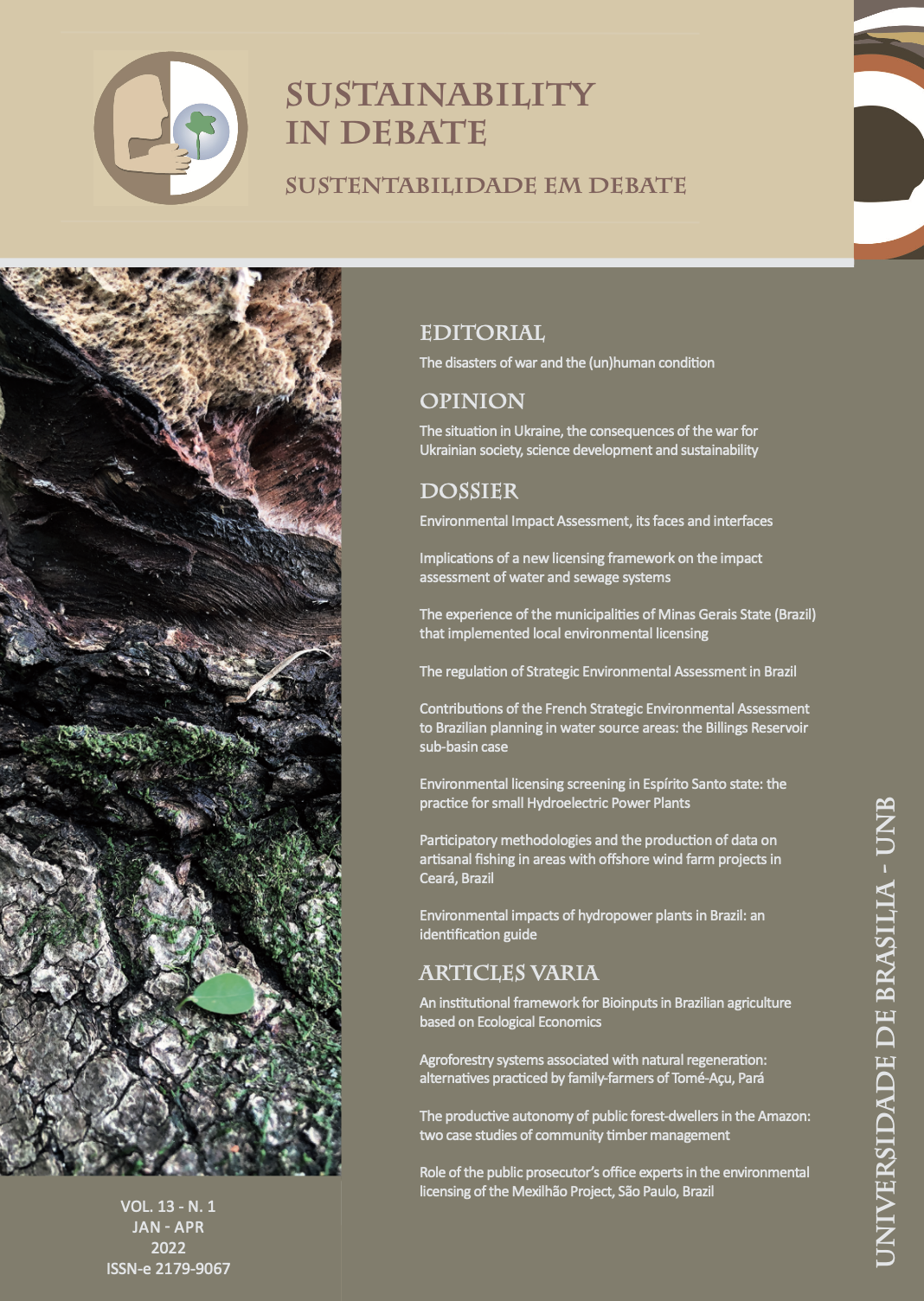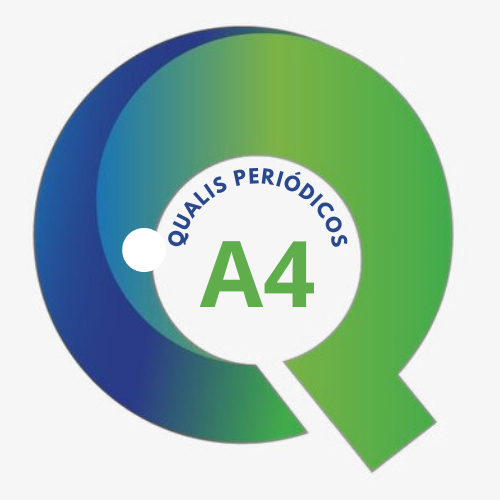Environmental licensing screening in Espírito Santo state: the practice for small Hydroelectric Power Plants
DOI:
https://doi.org/10.18472/SustDeb.v13n1.2022.40633Keywords:
Environmental Licensing, EIA, Screening, HydroelectricAbstract
In the context of Environmental Licensing (EL), project screening is an essential process that establishes whether Environmental Impact Assessment is needed or not. This paper analyzes the EL screening of a type of Small Hydroelectric Power Plants (less than 3 MW) in Espírito Santo state and compares it with other states in Brazil. The methodological process involved document analysis, good practices criteria application, and comparative analyses of the case study. The document analysis allowed us to understand how EL procedures in Espírito Santo have changed over time. The good practices criteria application allowed us to discuss how well processes aligned with outlined objectives. Finally, the comparative analysis between Espírito Santo and other Brazilian states allowed us to identify possible improvements for Espírito Santo's EL system. For example, screening could be improved by considering environmental sensitivity metrics for project classification and establishing guidelines for case-by-case analyses.
Downloads
References
ABEMA. Associação Brasileira de Entidades Estaduais de Meio Ambiente. Novas propostas para o licenciamento ambiental no Brasil. Brasília: Abema, 2013. 92p.
ALMEIDA, M. R. R.; MONTAÑO, M. Benchmarking na avaliação de impacto ambiental: o sistema mineiro frente às melhores práticas internacionais. Sociedade & Natureza, v. 27, n. 1, p. 81–96, 2015.
ALMEIDA, M. R. R.; MALVESTIO, A. C.; BERNADI, Y. R. Modifications of environmental licensing in Minas Gerais: advance or regression? Desenvolvimento e Meio Ambiente, v. 52, p. 91–113, 2019.
ATHAYDE, S. et al. Improving policies and instruments to address cumulative impacts of small hydropower in the Amazon. Energy Policy, v. 132, n. October 2018, p. 265–271, set. 2019.
BRASIL. Lei 13.097, de 19 de janeiro de 2015. Altera legislação do setor energético e dá outras providências. Brasília: Presidência da República, 2015. Diário Oficial da União (DOU), 20 Jan. 2015.
BRASIL. Lei Federal 6.938/1981. Dispõe sobre a Política Nacional do Meio Ambiente, seus fins e mecanismos de formulação e aplicação, e dá outras providências. Diário Oficial da União (DOU), 02 set. 1982.
BRASIL. Ministério de Minas e Energia. Resolução 875, de 2020. Estabelece os requisitos e procedimentos necessários à aprovação dos Estudos de Inventário Hidrelétrico de bacias hidrográficas e dá outras providências. Diário Oficial da União (DOU), 16 mar. 2020.
BRASIL. Ministério da Saúde. Resolução 510, de 2016. Dispõe sobre as normas aplicáveis a pesquisas em Ciências Humanas e Sociais cujos procedimentos metodológicos envolvem a utilização de dados diretamente obtidos com os participantes ou de informações identificáveis ou que possam acarretar riscos maiores. Diário Oficial da União (DOU), 24 mai. 2016.
CANTER, L. W.; CANTY, G. A. Impact significance determination – Basic considerations and a sequenced approach. Environmental Impact Assessment Review, v. 13, n. 5, p. 275–297, 1993.
CORRÊA FILHO, H.; PONTE, M. X.; SOARES, S. R. Avaliação do Ciclo de Vida da Farinha de Mandioca. Espacios, v. 38, n. 59, 2017.
CRUZ, F. B.; VERONEZ, F. A.; MONTAÑO, M. Evidence of learning processes in EIA systems. Impact Assessment and Project Appraisal, v. 36, n. 3, p. 242–252, 4 maio 2018.
ESPÍRITO SANTO. Decreto 4.344, de 8 de outubro de 1998. Regulamenta o Sistema de Licenciamento de Atividades Poluidoras ou Degradadoras do Meio Ambiente, denominado Slap, com aplicação obrigatória no Estado do Espírito Santo. Diário Oficial do Estado (DOE), 8 out. 1998.
ESPÍRITO SANTO. Decreto 1.777, de 8 de janeiro de 2007. Dispõe sobre o Sistema de Licenciamento e Controle das Atividades Poluidoras ou Degradadoras do Meio Ambiente, denominado Silcap. Diário Oficial do Estado (DOE), 8 jan. 2007.
ESPÍRITO SANTO. Instrução Normativa 14-N, de 7 de dezembro de 2016. Dispõe sobre o enquadramento das atividades potencialmente poluidoras e/ou degradadoras do meio ambiente com obrigatoriedade de licenciamento ambiental junto ao Iema e sua classificação quanto a potencial poluidor e porte. Diário Oficial do Estado (DOE), 12 dez. 2016, 2016a.
ESPÍRITO SANTO. Decreto 4.039, de 7 de dezembro de 2016. Atualiza as disposições sobre o Sistema de Licenciamento Ambiental e Controle das Atividades Poluidoras ou Degradadoras do Meio Ambiente – Silcap. Diário Oficial do Estado (DOE), 8 dez. 2016, 2016b.
ESPÍRITO SANTO. Instrução Normativa 15-N, de 23 de setembro de 2020. Dispõe sobre o enquadramento das atividades potencialmente poluidoras e/ou degradadoras do meio ambiente com obrigatoriedade de licenciamento ambiental no Iema e sua classificação quanto a potencial poluidor e porte e dá outras providências. Diário Oficial do Estado (DOE), 24 set. 2020.
FONSECA, A.; RESENDE, L. Boas práticas de transparência, informatização e comunicação social no licenciamento ambiental brasileiro: uma análise comparada dos websites dos órgãos licenciadores estaduais. Engenharia Sanitária e Ambiental, v. 21, n. 2, p. 295–306, 2016.
FONSECA, A.; SÁNCHEZ, L. E.; RIBEIRO, J. C. J. Reforming EIA systems: a critical review of proposals in Brazil. Environmental Impact Assessment Review, v. 62, p. 90–97, 2017.
GARBACCIO, G. L.; SIQUEIRA, L. N.; ANTUNES, P. B. Licenciamento ambiental: necessidade de simplificação. Justiça do Direito, v. 32, n. 3, p. 562-582, 2018.
GLASSON, J.; THERIVEL, R.; CHADWICK, A. An introduction to environmental impact assessment. 3. ed. London: Routledge, 2005.
IGNÁCIO, L. R.; ALMEIDA, M. R. R.; MONTAÑO, M. Zoneamento, Avaliação de Impacto e Licenciamento: levantamento da relação desses instrumentos dos estados brasileiros. In: 2A CONFERÊNCIA DA REDE DE LÍNGUA PORTUGUESA DE AVALIAÇÃO DE IMPACTOS /1O CONGRESSO BRASILEIRO DE AVALIAÇÃO DE IMPACTO. Anais [...]. São Paulo: ABAI, 2012.
INTERNATIONAL ASSOCIATION FOR IMPACT ASSESSMENT AND INSTITUTE FOR ENVIRONMENTAL ASSESSMENT. Principles of environmental impact assessment best practice. UK, 1999. Available in: https://www.iaia.org/uploads/pdf/Principles%20of%20IA%2019.pdf. Access on: 19 dez. 2021.
MONTAÑO, M. et al. O zoneamento ambiental e sua importância para a localização de atividades. Pesquisa & Desenvolvimento Engenharia de Produção, v. 5, n. 1, p. 49–64, 2007.
MONTAÑO, M. et al. O papel do instrumento zoneamento ambiental no processo de licenciamento de atividades. In: CONGRESSO BRASILEIRO DE CIÊNCIA E TECNOLOGIA EM RESÍDUOS E DESENVOLVIMENTO SUSTENTÁVEL. Anais [...]. Florianópolis: ICTR, 2004.
MONTAÑO, M.; SOUZA, M. P. Impact Assessment Research in Brazil: achievements, gaps and future directions. Journal of Environmental Assessment Policy and Management, v. 17, n. 01, p. 1550009, mar. 2015.
NADEEM, O.; HAMEED, R. Evaluation of environmental impact assessment system in Pakistan. Environmental Impact Assessment Review, v. 28, p. 562–571, 2008.
OLIVEIRA, F. S. D. et al. Licenciamento ambiental simplificado na Região Sudeste brasileira: conceitos, procedimentos e implicações. Desenvolvimento e Meio Ambiente, v. 38, p. 461–479, 2016.
PINHO, P.; MCCALLUM, S.; CRUZ, S. S. A critical appraisal of EIA screening practice in EU Member States. Impact Assessment and Project Appraisal, v. 28, n. 2, p. 91–107, 1 jun. 2010.
POPE, J. et al. Advancing the theory and practice of impact assessment: setting the research agenda. Environmental Impact Assessment Review, v. 41, p. 1–9, jul. 2013.
RAJARAM, T.; DAS, A. Screening for EIA in India: enhancing effectiveness through ecological carrying capacity approach. Journal of Environmental Management, v. 92, n. 1, p. 140–148, 2011.
ROCHA, C. P. F.; FONSECA, A. Simulations of EIA screening across jurisdictions: exposing the case for harmonic criteria? Impact Assessment and Project Appraisal, v. 5517, p. 1–13, 2017.
ROCHA, C. P. F.; FONSECA, A. Simulações de Triagem de Projetos no Licenciamento Ambiental: uma análise comparativa dos sistemas estaduais no Sudeste brasileiro. In: 2° CONGRESSO BRASILEIRO DE AVALIAÇÃO DE IMPACTO, v. 1, n. 1, p. 264–270, 2014.
SÁNCHEZ, L. E. Avaliação de Impacto Ambiental: conceitos e métodos. 3. ed. São Paulo: Oficina de Textos, 2020.
SNELLEN, I. T. M.; THAENS, M.; VAN DE DONK, W. B. H. J. Public Administration in the Information Age: revisited. [s.l.] IOS Press, 2012. v. 9.
SOUSA, M. M. et al. Procedimentos de Triagem na Avaliação de Impacto Ambiental: estudos de caso de órgãos licenciadores brasileiros. In: 2° CONGRESSO BRASILEIRO DE AVALIAÇÃO DE IMPACTO, v. 1, n. 1, p. 452–457, 2014.
WOOD, G.; BECKER, J. Discretionary Judgment in Local Planning Authority Decision Making: screening development proposals for environmental impact assessment. Journal of Environmental Planning and Management, v. 48, n. 3, p. 349–371, 2005.
Downloads
Published
How to Cite
Issue
Section
License
Copyright (c) 2022 Sustainability in Debate

This work is licensed under a Creative Commons Attribution-NonCommercial-NoDerivatives 4.0 International License.
SUSTAINABILITY IN DEBATE – Copyright Statement
The submission of original scientific work(s) by the authors, as the copyright holders of the text(s) sent to the journal, under the terms of Law 9.610/98, implies in the concession of copyrights of printed and/or digital publication to the Sustainability in Debate Journal of the article(s) approved for publication purposes, in a single issue of the journal. Furthermore, approved scientific work(s) will be released without any charge, or any kind of copyright reimbursement, through the journal’s website, for reading, printing and/or downloading of the text file, from the date of acceptance for publication purposes. Therefore, the authors, when submitting the article (s) to the journal, and gratuitous assignment of copyrights related to the submitted scientific work, are fully aware that they will not be remunerated for the publication of the article(s) in the journal.
The Sustainability in Debate Journal is licensed under Creative Commons License – Non-Commercial-No-Derivation Attribution (Derivative Work Ban) 3.0 Brazil, aiming at dissemination of scientific knowledge, as indicated on the journal's website, which allows the text to be shared, and be recognized in regards to its authorship and original publication in this journal.
Authors are allowed to sign additional contracts separately, for non-exclusive distribution of the works published in the Sustainability in Debate Journal (for example, in a book chapter), provided that it is expressed the texts were originally published in this journal. Authors are allowed and encouraged to publish and distribute their text online, following publication in Sustainability in Debate (e.g. in institutional repositories or their personal pages). The authors expressly agree to the terms of this Copyright Statement, which will be applied following the submission and publishing by this journal.






